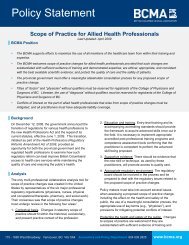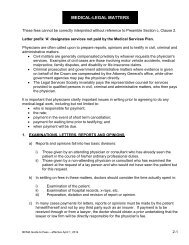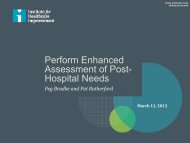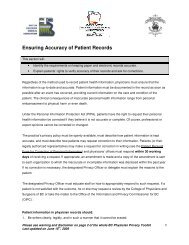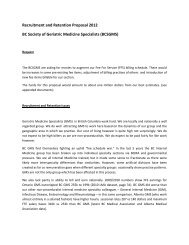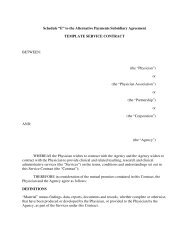Doctors Today and Tomorrow - British Columbia Medical Association
Doctors Today and Tomorrow - British Columbia Medical Association
Doctors Today and Tomorrow - British Columbia Medical Association
You also want an ePaper? Increase the reach of your titles
YUMPU automatically turns print PDFs into web optimized ePapers that Google loves.
I. The Physician Workforce: Planning for the future<br />
Planning for the future supply, mix, <strong>and</strong> distribution of the physician workforce is an important<br />
component of designing the overall health care delivery system. Planning begins by counting physicians<br />
<strong>and</strong> forecasting future requirements – which is not an easy exercise. To project how many physicians will<br />
be needed, a provincial planning framework is required. Also needed are valid measurement tools <strong>and</strong><br />
accessible, accurate, <strong>and</strong> reliable data on which to build effective policy.<br />
Counting Physicians<br />
At the most basic level, physician workforce planning requires an accurate count of physicians. The most widely-used<br />
method of measuring physician supply in BC is simple head counts. The College of Physicians <strong>and</strong> Surgeons of BC,<br />
the <strong>Medical</strong> Services Plan, the BCMA, <strong>and</strong> individual health authorities <strong>and</strong> hospitals all have rosters <strong>and</strong> databases of<br />
physicians, making it easy for analysts to generate lists of head counts.<br />
However, such ease comes at a price. The assumption on which head counts are based – that one physician is equal<br />
to any other physician, at least for the purpose of physician resource planning – is flawed. Practice patterns, level of<br />
practice intensity, <strong>and</strong> even hours worked can vary enormously among physicians. When these variations are ignored,<br />
head counts are poor estimates of the “real” number of physicians.<br />
Some of the shortcomings of using simple head counts can be addressed by calculating “full-time equivalents” (FTEs).<br />
The FTE method assigns a single value to each physician, which quantifies a physician’s practice relative to what is<br />
considered a full-time load. There are three approaches used in Canada for calculating physician FTEs (Task Force Two,<br />
2005):<br />
• The fee-for-service FTE model used by the Canadian Institute for Health Information applies a set of national<br />
specialty specific benchmarks that are based solely on fee-for-service clinical billings.<br />
• Alternative payment plan FTE models use a variety of methodologies to measure the proportion of physician<br />
payments that are not reimbursed on a fee-for-service basis (e.g., salary, sessional, population-based funding,<br />
blended).<br />
• The hours worked per week FTE model weighs physician counts in relation to hours worked per week as<br />
reported on physician surveys.<br />
The fee-for-service FTE model is the most commonly used approach of these three because billing data are readily<br />
available <strong>and</strong> regularly updated. However, this model underestimates physician supply because it does not capture<br />
recent changes in practice patterns such as the growing movement toward non-fee-for-service physician payments.<br />
Alternative payment plan FTE models can help capture the diversity of physician practice, but a major limitation to<br />
them is the lack of a st<strong>and</strong>ardized methodology in Canada.<br />
The hours worked per week FTE model has the potential to capture, in a st<strong>and</strong>ardized manner, the workload of<br />
physicians under all types of payment arrangements <strong>and</strong> could facilitate comparisons with other health care providers.<br />
However, this model has limited ability to verify the accuracy <strong>and</strong> consistency of self-reported data on working hours.<br />
As well, productivity is not taken into account.<br />
<strong>Doctors</strong> <strong>Today</strong> <strong>and</strong> <strong>Tomorrow</strong> – The Physician Workforce: Planning for the future 5



